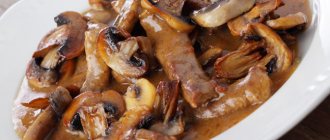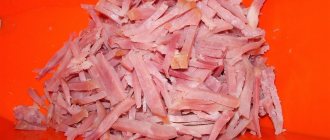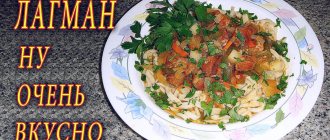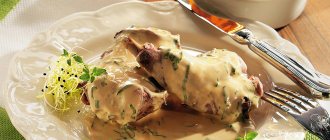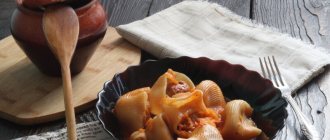Lagman is a favorite dish of most residents of Uzbekistan; it is also common in Kyrgyzstan and Turkmenistan, Japan and China. It can be found very rarely on the regular menu of Russian housewives, but in vain, because the dish is very nourishing, tasty, and aromatic.
It is impossible to say exactly what lagman is - a soup or a main course. It is so filling and can basically replace an entire lunch. After all, it has enough calories, there is meat, vegetables, homemade noodles, and vaja (gravy).
Let's dive into history before we get acquainted with the classic lagman recipe and its variations.
Historical reference
There are a huge number of variations of lagman, and each of them is tasty and unique in its own way. There is an assumption that the dish came to us from China, and there is also a legend there that tells about the origin of this wonderful dish.
The legend says: three travelers stopped at the crossroads of two roads. They walked for a long time, unknown from where and unknown where, each of them had their own goal, but they had something in common. A feeling of hunger forced them to stop at an intersection. They didn't know how to feed themselves, but they each had something in stock. The first traveler walked with a Chinese frying pan (wok), the second had a piece of meat and a handful of flour, and the third carried vegetables. It was radish and spices. One of the travelers was a chef's apprentice, and he offered to prepare a dish from what he had in order to be satisfied and continue his long journey. Everyone trusted him, and when the dish was ready, they were amazed by the taste. It had the right amount of spices, meat, flour and vegetables, it was very filling and tasty.
While they were eating, a Chinese rich man passed by, he stopped and tried what the travelers were eating. He did this not because he was hungry, but because he felt how wonderful the aroma emanated from the dish. He really liked the dish, and the rich man offered to sell this dish throughout all Chinese cities.
It is believed that this is a dish of the indigenous Dungans, who inhabited the territory of Ancient China at that time. And because of the migration of this people, their national dish spread and became a favorite among all the peoples of East Asia and beyond.
Useful tips
In different countries and regions, lagman is prepared in its own way, with the addition of different ingredients, but there are common basics that allow you to prepare a real, unusually tasty Central Asian lagman:
- For the dish, use the pulp of lamb or beef. Good-quality lamb is quite firm and elastic, has white fatty streaks. If the fat on the lamb turns yellow, this indicates that it is the meat of an old lamb or sheep. The age of an animal can be determined by the color of the meat - the younger it is, the lighter it is.
- Properly cooked noodles are an important part of a delicious lagman. It should be elastic and dense, but not hard. To do this, the dough is mixed with a soda solution, with the addition of eggs and sifted wheat flour.
- Vegetables for lagman cannot be cooked for a long time, otherwise they will boil and lose their shape. In addition, the carrots, peppers and radishes in the dish should be al dente and have a slight crunch.
- The best spices to pair with lamb are cumin, star anise, coriander, saffron and rosemary.
- Lagman is often prepared in the form of soup. Whether the dish will be thin or thick depends on how much broth is used to prepare it. For example, Uzbeks prepare their national dish with the addition of thick vaju, which contains practically no liquid.
Meat selection
Before preparing lagman, let's find out what kind of meat you need to buy.
At the moment, lagman is considered the national dish of Uzbekistan. The peoples of this territory are famous for raising sheep, so lamb is often used in all dishes. But beef is also popular there, especially soups with it. So we will also share the recipe for beef lagman.
But let's return to the classic recipe. When choosing meat, pay attention that it is young and juicy, because lagman should be appetizing, aromatic and satisfying. Any part of the carcass will do, but the meat should have a small layer of grease.
— Lazzhan —
Lazjan is a minor component for this dish in principle, but very important for Duang lagmans. It is a spicy dressing made from grated garlic with red and black ground pepper, poured with hot vegetable oil. It is not at all necessary to prepare lazhan during your first home experiments in preparing lagman, but as soon as you decide to take a step forward, remember that this dressing is added separately and not directly into the finished dish.
Required Ingredients
Classic Uzbek lagman is made from homemade noodles and vadzhi. To prepare noodles you will need:
- Flour - 5 cups.
- Vegetable oil - 200 ml.
- Eggs - 4 pcs.
- Salt - 2 tsp.
And for vajja you will need:
- Meat - 500 g.
- Sweet pepper - 6 pcs.
- Tomatoes - 5 pcs.
- Onion - 4 pcs.
- Carrots - 3 pcs.
- Turnip - 1 pc.
- Garlic - 1 pc.
- Beans - 150 g.
- Fat or oil - 170 ml.
- Spices, salt, jusai and herbs.
So, how to cook lagman? Cooking lagman begins with noodles. It is difficult to prepare, as it is difficult to knead, the dough is dense and thick.
Preparing waji
It is vaja, as the main component of the dish, that creates the main taste and imbues the dish with a unique aroma. Uzbek vaja is prepared in a cauldron with thick walls. In European conditions, you can use a deep cast-iron frying pan or a roasting pan. To prepare you will need the following products:
- lamb pulp – 500 grams;
- lard or fat – 150-200 ml;
- half a head of garlic;
- 3 onions;
- 2 medium potatoes;
- 2 carrots;
- 2 bell peppers;
- 3-4 ripe tomatoes;
- spices and salt - to taste.
When cutting lamb meat, you should separate the fat and pulp from the bones. The lamb is cut into cubes and fried in hot lard or fat until a beautiful dark crust is formed. Then season with onions, cut into rings. When the onion acquires a golden hue, add carrots and potatoes, chopped into strips.
Next, season with ripe, peeled tomatoes and simmer until tender. When the tomatoes begin to release juice, add bell peppers, cut into half rings, into the vaja. Dried spices are poured into a cauldron - red pepper, cumin, paprika and coriander, salt is added and chopped garlic is seasoned. Adding a glass and a half of meat broth, simmer over low heat for 30 minutes.
By the time the waji is ready, the noodles will have cooled down a bit. To warm up the noodles, dip them in boiling water for a moment or, placing them in a colander, immerse them in boiling water for 1-2 minutes. After waiting for the excess water to drain, they begin to place the noodles in deep plates or bowls.
Uzbek lagman is formed from layers of noodles and gravy. Place a layer of noodles on the bottom of the dish, a layer of gravy on top, then another layer of noodles, then gravy. At the end, sprinkle with chopped cilantro and garlic.
Noodles
The noodles take a long time to cook, several hours, so this dish takes a long time to prepare.
Mix the dough from eggs, flour, oil and water. Knead the dough thoroughly, do not be lazy. Form the dough into a ball or thick cake and cover it with a towel, let it rest for a couple of hours.
After two hours, knead the dough well. For Uzbek-style lagman, roll out the dough into a rope, twist and place on the bottom of a wide bowl, generously grease with vegetable oil and cover for half an hour.
Roll out the rope and cut into pieces no more than 2-3 cm wide. Roll into ropes of 15-20 cm, lay again and grease with oil, leave for half an hour.
Stretch the noodles, pull the end with one hand, roll a thin flagellum with the other. Then fold the flagella and beat them on the table, this will give them an even width.
The noodles should not be too thick, as they will swell during cooking, but they should not tear, they should be dense and elastic.
Below is a video showing the process of making homemade noodles.
The noodles for lagman are ready. All that remains is to boil it. Let's postpone this process until the second part of the lagman is ready; the noodles are cooked for only 3-4 minutes.
If you have a lot of noodles, brush them with oil and put them in a container; they will keep well in the refrigerator.
— Chuzma —
If the traditional basis of most dishes is meat, then in the case of lagman we would focus our attention on noodles. The authenticity of the entire dish will largely depend on how you prepare or what kind of lagman noodles you buy. The following is a recipe for homemade noodles for lagman, the so-called chuzma, but if it’s not important for you to do everything yourself, you can simply find a suitable pasta product in the supermarket.
Mutton
Separate the meat from the bones and cut into long strips. Heat the oil in a frying pan and fry until a crispy crust appears, the fat should melt and all excess water should come out.
In a container, deep frying pan or saucepan, add meat, all vegetables, add spices and stir everything over high heat.
Add water and close the container. When the water boils, reduce the heat and simmer for 15-20 minutes. Add salt, jusai, other favorite herbs and garlic, stir. Remove from heat after 3-5 minutes.
Beef
Since beef is a very tough meat, boil it before frying. You can boil the meat whole, and then chop and fry it, or cook it already chopped.
Place the beef in a frying pan and fry over high heat for several minutes, then add a little broth to the frying pan and simmer.
Simmer the eggplants and onions separately for about half an hour so that they are soft and not bitter, add vegetables. To prevent the broth from wasting, pour beef broth over the vegetables instead of water. It will be more filling this way. Add your favorite spices to beef. This beef lagman recipe can be prepared by anyone in their own kitchen.
— Broth —
Another important ingredient, without which lagman will look more like Italian pasta than a Central Asian dish, is a simple broth. And it doesn’t matter at all what kind of broth it is - chicken, meat, vegetable! We wouldn't recommend using fish broth, but that's up to your taste.
As we already wrote above, the amount of broth added will ultimately determine what exactly ends up on your plate in finished form - soup or a main course, so think carefully before using this component of the lagman.
Lagman with chicken
Lagman with chicken is the “lightest” version of the dish, since chicken breast is the most dietary meat that can be used.
Cut out the fatty veins and cut into pieces. White chicken meat is a bit dry, so to make the chicken lagman juicy, marinate the breast pieces. An hour is enough for the chicken to soak in your favorite marinade.
Meat cooks quickly in a frying pan, so the dish rightfully deserves the title of the fastest lagman.
You can speed up the preparation of lagman using store-bought noodles.
Features of lagman among different nations
Now there are so many recipes for this dish that it is quite difficult to classify it. I will try to name the main options used.
- Uyghur version. This dish has more of a side dish consistency than a soup. And the gravy for lagman is prepared with minimal use of liquid.
- Dungan recipe. Any amount of liquid to taste is allowed in it. There is a cooking option with fried noodles (zhadi - lyumyan).
- Lagman of Uzbek cuisine. It has the consistency of a classic soup, so there aren't many noodles in it.
- Lagman of Kazakh cuisine. This recipe includes an omelette. The omelette is fried separately, and then cut into strips and added to the soup when serving.
- Lagman Tajik. At the final stage of cooking, sour milk is added.
The above classification is rather arbitrary. Within each species there are many more subspecies. Even every family has its own recipe.
Whatever cooking method is chosen, you need to put your soul and love into the cooking process. And then a dish of any cuisine will turn out excellent.
Secrets of a successful lagman
So we told you how to cook lagman. This is a delicious, satisfying dish for the whole family. To ensure that your dish turns out great, we will leave you with a few simple tips for preparing lagman at home.
- The ideal container for preparing lagman is a cauldron. It has a convenient form for preparation.
- Try not to overcook the vegetables. They may lose their taste, so it's better to be firm but with a natural taste.
- To prevent the dough from sticking to your hands, periodically wet your hands in salt water.
- Experiment with vegetables, adding your favorite ones to suit your taste.
- Spices will enhance the taste of lagman. Pay attention to what spices are suitable for the meat you choose. Universal spices for lagman are achik, cumin, cloves, coriander, black pepper.
We got such a juicy, appetizing, satisfying dish. Preparing lagman takes a lot of time, but the result is worth it.
How to cook lagman soup - 15 varieties
- Delicious soup Lagman
- Lagman with homemade noodles
- Uzbek soup lagman
- Lagman with zucchini and Chinese cabbage
- Uyghur lagman
- Lagman in a simple way
- Lagman at home
- Lagman at home
- Cooking lagman at home
- Lazy Lagman
- Vegetarian lagman
- Simple lagman with beans
- Lagman with chickpeas and udon noodles
- Lagman with lamb and spaghetti
- Lagman with mushrooms and rice noodles
